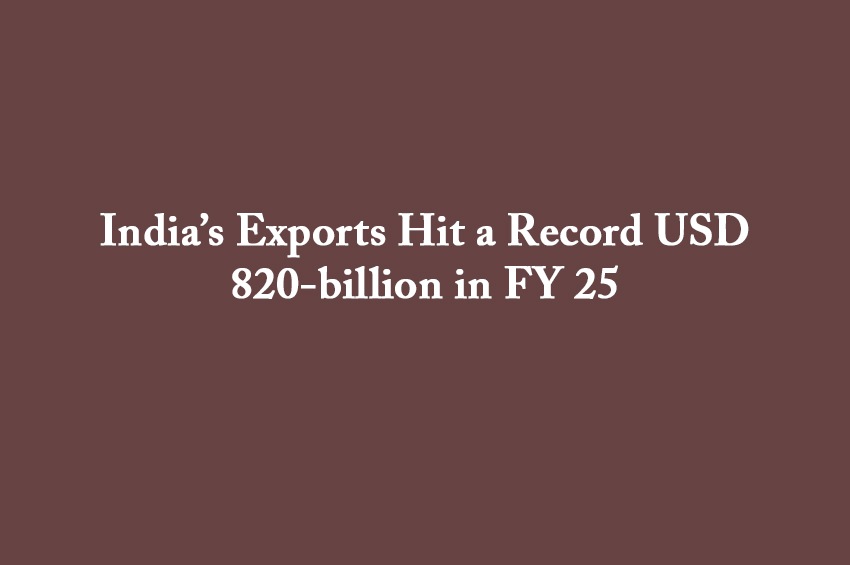Winning Bizness Economic Desk
India’s Exports Hit a Record USD 820-billion in FY 25
India has performed very creditably on the exports front with its exports climbing up steeply to hit a record USD 820.93-billion in the last fiscal (year-ending March 31, 2025).
This is a healthy increase of 5.5 per cent over the previous year’s USD 778.13-billion, according to the Union Ministry of Commerce.
An important point to highlight here is that services exports were at the forefront, registering a Year-on-Year (YoY) surge of 12.45 per cent. However, merchandise exports increased only slightly to USD 437.42-billion from USD 437.07-billion in the previous year (FY 24).
The key segments included telecommunications, IT and business services, travel and financial services.
The United States (US), the UAE, United Kingdom (UK), Japan and the Netherlands emerged as the country’s top export destinations. Major import sources remained India’s northern neighbour China, Russia and the Gulf nations.
Smartphone exports to the United States increased from USD 4.7-billion to USD 7.4-billion and to the United Kingdom from USD 0.2-billion to USD 1.5-billion.
India entered new markets in agri-exports, exporting green papaya for the first time to Dublin and London.
India Likely to Surpass Japan’s GDP Soon, Overtake Germany by 2027: IMF
The globally well-known International Monetary Fund (IMF) has said that India is well on track to surpass Japan and become the world’s fourth-largest economy by the third-quarter (Q3) of this year.
The country’s GDP has more than doubled in the last decade, climbing up from USD 2.1-trillion in 2015 to an estimated USD 4.3-trillion this year (2025).
The IMF data shows that the country is fast closing-in on Japan. Presently, India is the fifth-largest global economy. Japan’s GDP stands at USD 4.4-trillion.
While India’s economy expanded by a very healthy 105 per cent in the last ten-years, Japan’s GDP has remained more or less stagnant.
What needs to be noted here is that if India continues to grow in the same vein, then it could overtake Germany’s economy by the second-quarter (Q2) of 2027. Presently, the European economic powerhouse is the world’s third-largest economy with a GDP of USD 4.9-trillion.
An interesting point here is that India has registered a higher GDP growth rate than several major global economies in the past decade. The highlight here is that India’s economic expansion has outpaced neighbouring China, the United States and several leading European countries besides.
Presently, the United States holds the top position with a GDP of USD 30.3-billion, followed by China at USD 19.5-trillion.
India’s Inflation Slides to 3.34 Per Cent in March
The country’s annual inflation rate slid to a lower-than-expected 3.34 per cent in March of this year—the fifth straight month of a decline. In the previous month (February 2025), the inflation number came in at 3.61 per cent.
The decline was mainly due to a softening of food prices with food inflation, a key constituent of the country’s Consumer Price Index (CPI) touching 2.69 per cent.
There was a fall in prices of vegetables, spices, eggs and pulses.
The inflation data follows a second straight interest rate cut by the country’s apex bank—the Reserve Bank of India (RBI). It has cut rates by 0.25 per cent twice in recent months, bringing the repo rate down to six per cent.
The Reserve Bank estimates inflation at four per cent at the mid-point of its target range of two-to-six per cent for the financial year-ending March 2026, although it noted that core inflation in February—which excludes food and fuel prices—moved northward to a 15-month high of 4.1 per cent driven mostly by an increase in gold prices.
“There has been a substantial and broad-based seasonal correction in vegetable prices. The uncertainties on rabi (winter) crops have abated considerably….Along with robust kharif (autumn) arrivals, this is expected to set the stage for a durable softening in food inflation,” the Reserve Bank said.
An important point to note here is that with the inflation numbers on a southward trend, the Reserve Bank could cut the repo rate further going forward in a bid to stimulate growth.
The RBI Governor Mr Sanjay Malhotra said that the bank would shift its stance from neutral to accommodative with the aim of perking-up the economy through lower interest rates.It needs to be highlighted here that the country’s GDP expanded by a lower-than-expected 6.2 per cent in Q4 of 2024. Its economy is estimated to have grown 6.5 per cent in the financial year ended March 31, 2025, which is a huge dip from the 9.2 per cent of the previous fiscal (year-ending March 31, 2024).
India’s Forex Reserves Rise for Sixth Straight Week to Hit USD 677.84-bn
India’s foreign exchange (forex) reserves increased by USD 1.567-billion to USD 677.835-billion in the week ended April 4.
The significant highlight here is that this is the sixth consecutive week of increase in the reserves.
According to the Reserve Bank of India (RBI) data, the Foreign Currency Assets (FCAs) moved northward by USD 892-million to USD 574.98-billion.
Foreign Currency Assets are the major constituents of foreign exchange reserves.
Gold reserves also registered an increase by USD 638-million to USD 79.997-billion during the week, the Reserve Bank data showed. However, the Special Drawing Rights (SDRs) slipped by USD 6-million at USD 18.356-billion.
According to India’s apex bank, the country’s foreign exchange reserves are sufficient to cover around 10-to-11 months of projected imports.
The point to note here is that the country’s forex market has seen a strong growth in recent years, with average daily turnover nearly doubling from USD 32-billion in 2020 to USD 60-billion in 2024.
In 2023, India added around USD 58-billion to its foreign exchange reserves contrasting with a cumulative decline of USD 71-billion in 2022. Last year (2024), the reserves climbed up a little over USD 20-billion.
Foreign exchange reserves or FX reserves are assets held by a country’s central bank or monetary authority, primarily in reserve currencies such as the US Dollar, with smaller portions in other currencies such as the Euro, the Japanese Yen and Pound Sterling.
ADB Projects India’s FY 26 GDP Growth Rate at 6.7 pc
The Asian Development Bank (ADB) has projected India’s GDP growth rate for this fiscal (FY 26) at 6.7 per cent. This, it must be pointed out, is a reduction from the ADB’s earlier growth forecast of seven per cent.
“A major risk arises from US tariff levies on India’s and other countries’ exports, which could reduce trade and investment flows and potentially create volatility in the domestic financial market,” the ADB said in its latest outlook report.
The global economic uncertainty may also affect completion of investment projects in the country, the globally well-reputed organisation said in its report.
The ADB said that these risks could potentially be mitigated by a trade agreement between India and the United States (US) which is being negotiated and the fact that India’s merchandise exports to the US account for a relatively low of two per cent of GDP.
Favourable monetary and fiscal policies, increasing rural incomes and moderating inflation would support India’s growth, the ADB added.


